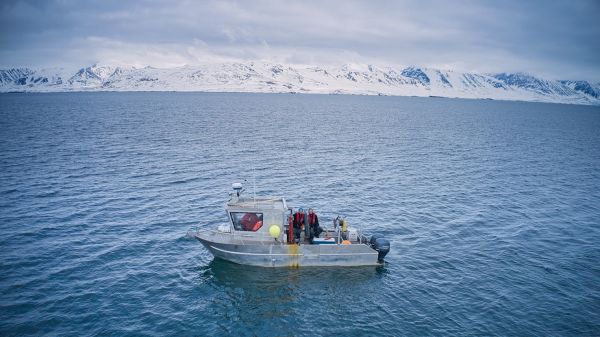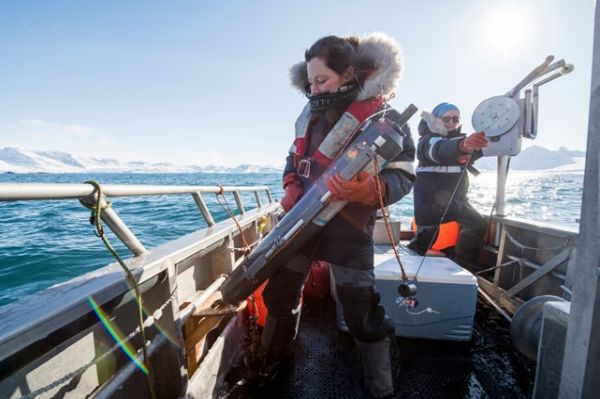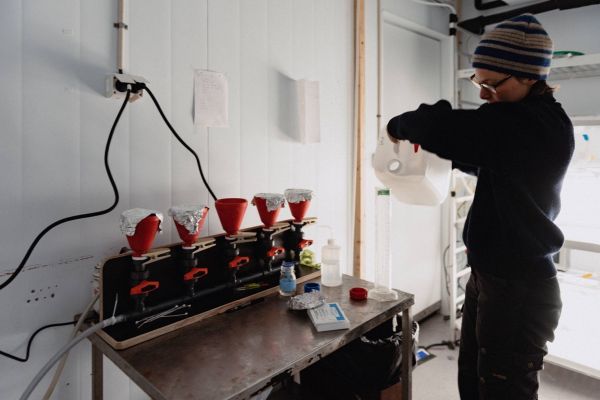Environmental Bloom Controls and Adaptive Mechanisms in Svalbard (EBCAMS)
by Clara J. M. Hoppe & Klara K.E. Wolf, Alfred Wegener Institute
 The ecosystem of the Arctic Ocean, similarly to other marine ecosystems, depends on primary production provided by tiny little plants that grow in the ocean surface – the phytoplankton. Phytoplankton are also important for global biogeochemistry and climate because the produce oxygen and store carbon in the ocean. Our project ‘Arctic phytoplankton under multiple stressors’ (AMUST), combines long-term monitoring of the main growing season of phytoplankton in Kongsfjorden with experiments on climate change effects.
The ecosystem of the Arctic Ocean, similarly to other marine ecosystems, depends on primary production provided by tiny little plants that grow in the ocean surface – the phytoplankton. Phytoplankton are also important for global biogeochemistry and climate because the produce oxygen and store carbon in the ocean. Our project ‘Arctic phytoplankton under multiple stressors’ (AMUST), combines long-term monitoring of the main growing season of phytoplankton in Kongsfjorden with experiments on climate change effects.
Originally planned for 2020, our SIOS-funded fieldwork was meant to extend the time series dataset by one more year, and to deepen our understanding of the coupled physical-biological system. Due to the Covid-19 pandemic, our fieldwork in Ny-Ålesund planned for April and May had to be postponed by one year. In April 2021, and after spending 10 days in hotel quarantine in Oslo, we finally arrived in Svalbard.
During our 6-week long stay, we sampled the Kongsfjorden spring bloom 2-3 times per week from board the AWIPEV research vessel Jean Floc’h. Sampling included physical (e.g. temperature and salinity), chemical (e.g. nutrient and dissolved inorganic carbon) and biological parameters (e.g. species composition, primary production). We could observe how biomass increased exponentially and then started declining once nutrients were depleted. We also observed a typical succession of species, with diatoms dominating the beginning and the colony-forming Phaeocystis dominating at the end of the bloom.
The collected data supports our findings from previous years that dynamics in the so-called mixed layer depth, so the stability of the upper water column, affect the productivity and species composition of the spring bloom. We also successfully visited the nearby Krossfjorden system, where sampling will help to better understand the population-dynamics of the important spring bloom diatom Thalassiosira hyalina, for which we recently developed a molecular method (Wolf et al. 2021, Environmental Microbiology).


Photo captions:
Figure 1: The field team onboard the AWIPEV research vessel Jean Floc’h during sampling in Kongsfjorden (photo: T. Czart/ AWI)
Figure 2: Water samples are collected using Niskin bottles attached to Jean Floc’hs electric winch (photo: G. Tran/AWI).
Figure 3: Back in the laboratory, water samples are filtered for various analyses (e.g. contents of chlorophyll a, particulate organic carbon and nitrogen, as well as genetic analyses) (photo: D. Wojtanowicz). Most of the samples are brought back to AWI in Germany for chemical analyses.



























